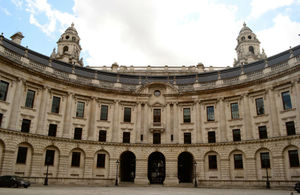Lloyd’s of London given highest listed status as heritage from prehistoric to postmodern is protected
Star Carr in Yorkshire also made a scheduled monument.

Two of Britain’s most outstanding heritage assets - the first believed to be one of the very earliest known sites of occupation in England, the other a postmodern icon in the heart of the City of London - were given protection today by Heritage Minister John Penrose.
On the advice of English Heritage, the Lloyd’s building in central London has been given Grade I listed status for its architectural innovation, historic interest and celebrated design. And the early Mesolithic settlement Star Carr near Scarborough, North Yorkshire is being made a scheduled monument for its rarity and archaeological importance.
John Penrose said:
“From the dawn of civilisation in this country to the white heat of late 20th century technology both these sites are incredibly important to Britain’s heritage landscape.
“The diversity of finds on offer at Star Carr and its history which goes back to 9000 BC are unequalled in British archaeology and it remains one of the most important Mesolithic sites in Europe.
“At the other end of the spectrum the Lloyd’s building designed by the Richard Rogers Partnership stands the test of time with its awe-inspiring futuristic design which exemplifies the High Tech style in Britain. It clearly merits the extra protection against unsuitable alteration or development that listing provides.”
English Heritage’s Designation Director Roger Bowdler said:
“We are delighted that the Minister has endorsed our advice to list the landmark Lloyds building at Grade l. Its listing at the highest grade is fitting recognition of the sheer splendour of Richard Rogers’s heroic design. Its dramatic scale and visual dazzle, housing a hyper-efficient commercial complex, is universally recognised as one of the key buildings of the modern epoch. At Star Carr, in Yorkshire, we also find innovation - an internationally important Mesolithic site which contains what may be the earliest building in Britain. Extraordinary rich in finds, the site sheds much light on the activity of our hunter-gatherer forbears and the early use of stone tools. Designation as a Scheduled Ancient Monument recognises this significance and will help with its appropriate care and management, while ongoing excavations will continue to enhance our understanding of this fascinating period of prehistory.”
The Lloyd’s building in the City of London was opened in 1986 and is a 20th century High Tech office building and insurance market for the major insurance firm Lloyd’s. Lloyd’s takes its name from Edward Lloyd, a Welshman who opened a coffee house in Tower Street in 1688 and became a meeting place for seafarers, ship-owners, and the first underwriters who insured the ships and their cargoes. The main interior space of the building is organised around a central, soaring atrium with a columnar structure and expressed ductwork. From the outside the building is identified by the six different towers that engulf the core of the site. It is one of the best known and admired modern commercial buildings in the country.
Star Carr is an early Mesolithic occupation site near Scarborough, North Yorkshire and is an exceptionally rare site due to its remarkable survival of organic material from this prehistoric date and the evidence of built structures on the site. It is known for its great diversity of finds and archaeological features. Some of these are visually spectacular, such as the antler head-dresses now in the British Museum, while some, such as worked timbers demonstrate the early use of stone tools for carpentry, which remains unequalled in British archaeology.
Notes to Editors
- For copies of the advice reports please contact Emma Marsh in the DCMS Press Office on 0207 211 6271.
- For further press information or interview requests please call Helen Bowman in the English Heritage Press Office on 0207 973 3294.
Press Enquiries: 020 7211 2210
Out of hours telephone pager no: 07699 751153
Public Enquiries: 020 7211 6000